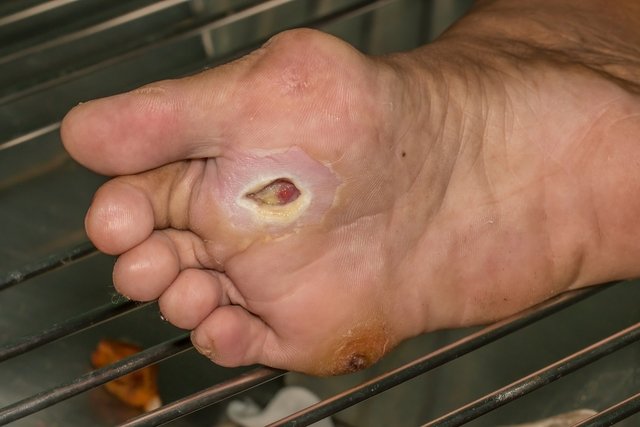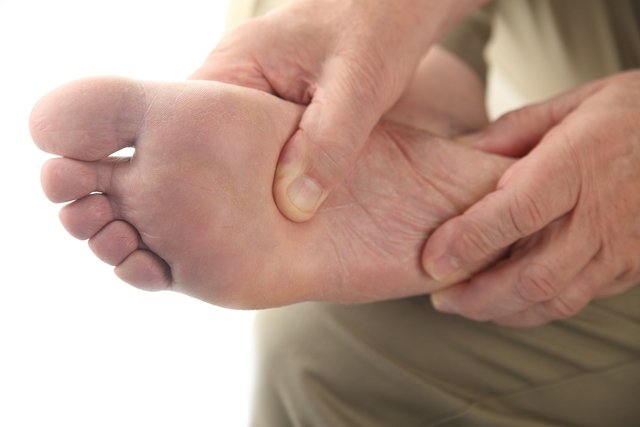Diabetic foot is a set of changes that appear in the feet of people with uncontrolled diabetes. Normally, the diabetic foot begins to appear as small wounds and ulcers that take time to heal and which, therefore, can cause infections, increasing the risk of amputation.
This type of complication is more common when blood sugar levels are very uncontrolled and, therefore, one of the best ways to prevent its occurrence is by taking appropriate diabetes treatment. Check out the 6 main complications of diabetes.
Furthermore, to avoid the appearance of diabetic foot, it is recommended to do the check-up regular foot treatment, which can be done daily at home, but must also be done by a doctor in the office. In cases where the diabetic foot is already present, it is very important to have the dressings done at the health center or hospital.
Sensitive content
This image may contain content that is uncomfortable for some people.

Main symptoms
The main symptoms of diabetic foot are:
- Wounds or ulcers on the feet that take time to heal;
- Constant pain or tingling;
- Loss of sensation in the foot;
- Foot swelling;
- Foul smell in the foot;
- Thicker skin on the foot;
- Pus comes out of the wounds;
- Changes in the temperature of the skin of the foot.
In the presence of any of these symptoms, it is very important to consult a doctor to carry out a detailed assessment of the skin and identify the risk of diabetic foot, initiating appropriate treatment.
How to confirm the diagnosis
The diagnosis of diabetic foot is made by a general practitioner or endocrinologist or vascular surgeon and is based on the signs and symptoms presented in the lower limb. However, the doctor can also use clinical instruments and/or order other tests to confirm the diagnosis, such as the Rydel-Seiffer tuning fork, which is used to produce a vibration that the person must be able to feel in the foot. Another very common exam is the Eco-doppler, in which an ultrasound is applied to evaluate the blood flow in the large arteries and veins of the arms and legs.
Who is most at risk of diabetic foot
The appearance of diabetic foot is more common in people with:
- Diagnosed with diabetes more than 10 years ago;
- Diabetic neuropathy;
- History of ulcers or lower limb amputation;
- Changes in toenails.
This type of complication is also more common in men and in people who do not take adequate diabetes treatment or who do not see a doctor regularly for evaluation.
How is diabetic foot classified?
There are two scales to identify the degree of development of the diabetic foot:
1. Wagner Classification
The use of this scale has been decreasing, having been replaced by the Texas scale. In this classification there are 6 degrees, according to the type of changes present:
- Grau 0: high-risk foot, but without wounds or ulcers;
- Grade I: presence of superficial ulcer;
- Grade II: presence of deep ulcer, with tendon involvement;
- Grade III: ulcer with bone involvement;
- Grade IV: localized gangrene;
- Grade V: gangrene of the foot.
2. Texas Classification
This scale was developed by the University of Texas and classifies diabetic foot injuries according to the depth and presence of infection or ischemia in the foot:
It is important that all diabetic foot injuries are evaluated and classified by the doctor, as this will help to adapt the necessary treatment and care.
How the treatment is carried out
Diabetic foot treatment is carried out according to the signs and symptoms presented, in addition to the classification of diabetic foot injuries, and should always be guided by a doctor, even in the case of small cuts or wounds, as they can worsen quickly.
Treatment may involve:
- Use of antibiotics;
- Use of antimicrobial ointments on the affected area;
- New changes in diet or use of medications to control diabetes;
- Performing daily wound dressing.
In more serious cases, surgery may be necessary to remove the affected area of skin and promote healing. However, when the wound is not detected at an early stage or when the patient does not comply with treatment properly, the affected region may be very large, and it may be necessary to amputate the foot or part of the foot.
In some cases, when the ulcer is very deep and requires very constant care, admission to the hospital may be recommended.
5 essential diabetic foot care
Some fundamental precautions that must be maintained during treatment, but which also help to avoid the development of diabetic foot are:
1. Keep blood sugar controlled
This is the most important step in treating or preventing diabetic foot, because when sugar levels remain high for a long time, blood has more difficulty reaching the extremities of the body, and the feet are the region most affected by poor circulation. .
Thus, when there is little blood reaching the feet, the cells become weak and the foot begins to lose sensitivity, causing cuts or wounds to heal very slowly and are only noticed when they are at a very advanced stage.
2. Observe your feet daily
Due to the risk of loss of sensitivity, diabetics should make a habit of evaluating their feet daily, whether at bath time or when waking up, for example. If your physical condition does not allow it or if visibility is not good, you can use a mirror or ask for help from another person when inspecting your feet.
It is necessary to look for cracks, chilblains, cuts, wounds, calluses or changes in color, and you should consult a doctor if you notice the presence of any of these changes.
3. Keep your feet clean and hydrated
You should wash your feet every day with warm water and neutral soap, taking care to clean between the toes and the heel. Afterwards, dry your feet with a soft towel, without rubbing the skin, just drying with light pressure from the towel.
After washing, it is also important to apply an unscented moisturizer all over the foot, being careful not to leave cream accumulated between the toes and nails. Let it dry naturally before wearing socks or closed shoes.
4. Cut your nails twice a month and do not remove calluses
It is important to avoid doing your nails too frequently, ideally only doing it twice a month, so as not to encourage the appearance of nail corners or ingrown toenails. Furthermore, you should avoid removing the cuticle, as it is important to protect the skin from wounds and scratches.
It is also important to cut your nails straight, and calluses should only be removed by a professional who specializes in feet and is aware of the presence of diabetes. If calluses appear very frequently, you should speak to your doctor to investigate the causes and begin treatment.
5. Wear soft, closed shoes
The ideal shoe for diabetics must be closed, to avoid wounds and cracks, in addition to being soft, comfortable and with rigid soles, to provide safety while walking.
Women should prefer low, square heels, which provide better balance for the body. Plastic, pointy or tight shoes should be avoided, and a good tip is to always have a second pair of shoes to change in the middle of the day, so that the foot does not suffer the pressure and discomfort of the same shoe for a long time. .
Possible complications of diabetic foot
The most common complications of diabetic foot are lower limb infection, pain or numbness in the area and ischemia. The main and most serious complication of the diabetic foot is the amputation of the lower limb, that is, the surgical cutting, whether just of the foot or the leg.
Furthermore, as diabetic neuropathy is an advanced stage of diabetes, the person may experience vision problems such as blindness and even kidney problems that lead to dialysis or hemodialysis treatment after surgery. The most common diabetic foot infection is osteomyelitis, which can lead to skin amputation due to poor control of the disease. Learn more about the symptoms and treatment of osteomyelitis. Understand better what diabetic neuropathy is and how to avoid it.




